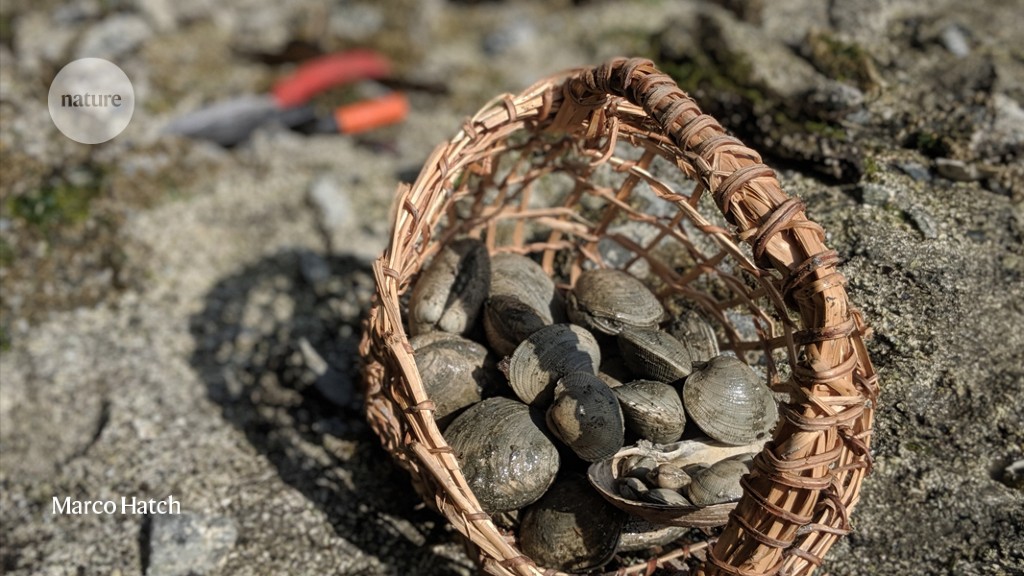NSF invests millions to unite Indigenous knowledge with Western science

Research centre launched by the US National Science Foundation will partner with native peoples to study farming, climate and more

One of the first projects to be launched by the NSF’s new centre on Indigenous knowledge will focus on ancient clam-farming practices along the Pacific coast.Credit: Marco Hatch
The US National Science Foundation (NSF) has funded its first research hub focused on Indigenous knowledge. The move comes amid discussions of colonialism in science, and a reckoning that researchers must do more to engage with native peoples when seeking their expertise in everything from flora and fauna to medicines, weather and climate.
Launched yesterday with US$30 million in funding over five years, the Center for Braiding Indigenous Knowledges and Science (CBIKS) joins more than a dozen active NSF Science and Technology Centers across the United States that focus on core research areas. It will be based at the University of Massachusetts (UMass) Amherst.
The goal is to cultivate Indigenous knowledge of the environment, and weave it together with Western scientific methods in a way that respects local communities and cultures, says Sonya Atalay, an archaeologist of Anishinaabe-Ojibwe heritage at UMass Amherst and co-leader of the centre.
“As Indigenous people, we have science, but we carry that science in stories,” Atalay says. “We need to think about how to do science in a different way and work differently with Indigenous communities.”
For co-leader Jon Woodruff, a sedimentologist at UMass Amherst, the centre turns a standard scientific methodology on its head: rather than thinking about scientific theory and then moving from a global to local scale, Indigenous scholars are starting with places, communities and cultures first and then branching out to the wider world. It’s an approach that holds enormous promise as communities around the globe seek to confront climate change, says Woodruff, who also co-directs the Northeast Climate Adaptation Science Center at UMass Amherst.
To meet societal challenges, he adds, “we need a balance of both approaches”.
Local knowledge
The new centre — launched alongside three others, focused on advanced acoustics, quantitative cell biology and the particle physics of 3D printing — seeks to tap into a global pool of Indigenous knowledge with collaborators at eight hubs across four countries. One project set to launch in the first year at the Pacific Northwest hub focuses on a type of clam farming that has been practiced for thousands of years by native peoples along the Pacific coast of Canada and the United States.
Marco Hatch, a member of the Samish Indian Nation and a marine ecologist at Western Washington University in Bellingham, has spent nearly two decades working with Indigenous communities to investigate and revive this ancient technique. It involves using terraced gardens to extend and flatten a beach’s intertidal zone — where clams grow — and it can be two to four times more productive than conventional methods, Hatch says.
The leaders of CBIKS are (from left) archaeologist Ora Marek-Martinez, Atalay, Woodruff and anthropologist Bonnie Newsom.Credit: University of Massachusetts Amherst
With funding from the centre, Hatch adds that he and his collaborators will be able to expand their partnerships to Indigenous communities in Washington and Alaska. “There’s untold thousands of clam gardens up and down the coast that haven’t been identified,” he says. With guidance from a panel of Indigenous advisers, scientists will be able to conduct surveys at low tide, using boats and aerial drones.
Hatch, a co-leader of the Pacific Northwest hub, adds that lessons from this project will help to guide future studies at the centre. For instance, he thinks that his team’s practice of relying on Indigenous community members with technical backgrounds to act as intermediaries with external specialists can create a “fulcrum for partnership”.
That’s the part that Alex Whiting plays as the environmental programme director for the Native Village of Kotzebue in Alaska. He says that CBIKS is a step in the right direction in coming to grips with colonialism in science, but warns that there is no easy recipe for success.
Scientists need to recognize the value of Indigenous knowledge, Whiting says. They can start by reaching out and working to rebuild trust with Indigenous peoples, but native communities must also step up, he says. “Your chances of success increase as the amount of sincerity and engagement rises by both parties.”
Giving back
As well as advancing Indigenous science, CBIKS will attempt to set itself apart in how knowledge and information are managed, disseminated and ultimately returned to Indigenous communities.
Atalay says that her nightmare scenario is a well-established one in which, for example, scientists tap into local plant knowledge and publish and ultimately appropriate it for profit through drug companies. The centre has already developed its own protocols for managing intellectual property, to ensure that Indigenous communities have a say in how and when information is used by outside entities, she says.
Similarly, Atalay is thinking about ways to measure success and communicate findings that go beyond publishing papers in peer-reviewed journals. In particular, she says, scientists will focus on finding ways to communicate their results with communities, including through the use of comic books, posters and theatre.
“You share what you’ve learned, and you do that through stories, through art, through any accessible means,” she says. “That is not a side note. It’s an integral part of the circle of doing science.”
doi: https://doi.org/10.1038/d41586-023-02839-4
This story originally appeared on: Nature - Author:Jeff Tollefson


















